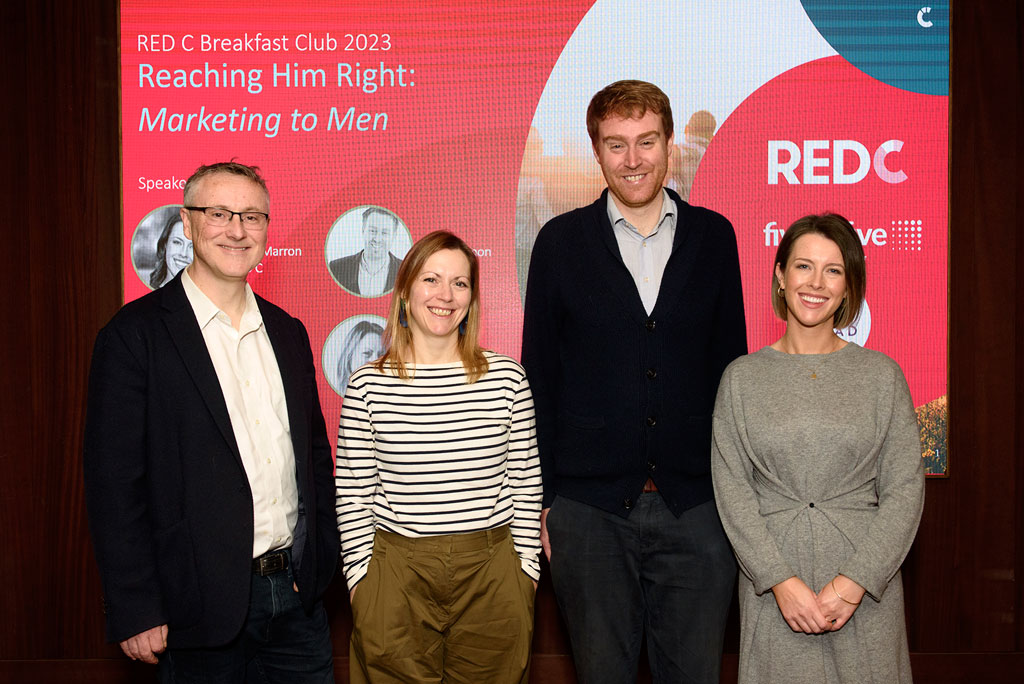
Following the RED C Breakfast Event on marketing to men earlier this week, Aoife Marron shares some of the findings and learnings from the event line-up.
As we sat down to plan the annual RED C Breakfast Event this year, the team ran through themes of interest to our clients. All the usual suspects came up (yes, we did flirt with the idea of another Gen Z discussion!), however a comprehensive Brand Reaction Index (BRI) study completed by colleagues in RED C was the acorn from which our idea grew.
RED C BRI scores revealed something quite interesting; women are more emotionally connected to brands than men. With so many qualitative researchers in the room, the inevitable “why” came up. We quickly identified a gap in industry conversation around men and what being like a man looks like today and what brands need to know about this to better connect.
The face-to-face event in the Mayson Hotel, saw RED C welcome over 100 industry clients and peers to learn more about this under engaged, yet significant target.
The speaker line up included me and my Qualitative & Strategy Director colleague, Robin McGhee, with UK-based contributors Mark Lemon (Associate Director in semiotics and cultural analysis agency Sign Salad) and Emmeline Kite (Head of Strategy in creative agency Five by Five). RED C Director, Ciara Clarke, was MC for the morning, facilitating a smooth run of proceedings.

RED C conducted fresh research into the topic, including a qualitative and national representative quantitative element. This self-funded piece presented at the event revealed that while the role of men has evolved in many ways, expectations of men have not advanced to the same degree.
One unanimous positive emerging from this change has been the progression of emotional openness and mental health, however data showed that while things have improved, they’re not great.
The research shows that almost 1 in 2 (48%) Irish men agree that they find it difficult to talk about their innermost feelings, with this figure was higher again for men aged 18-34 (56%).
The research revealed that deeper connection can be a real struggle for men and heavily reliant on traditional values, roles and interests.
For example, 57% of Irish men agree than being interested in sport is an important avenue for communication. As one of our focus group participants said, “if you don’t know anything about it [sport], it’s an immediate shutdown. It’s like a social slap in the face […] it’s a real faux pas.”
Interestingly, men also feel that very few brands are credibly and successfully aligning with more modern male values and connecting with them at a deeper level. The research found that only 12% agree that the media representation of masculinity today reflect their own views.
The advice emerging from the research, however, highlights the importance of pace in addressing this. While greater recognition of modern male values in brand communication needs to happen for better connection, it needs to happen slowly. Quick change can lead to conscious rejection by some.
Mark Lemon from Sign Salad shared a fascinating reveal of the codes of masculinity in Ireland currently and how the path of masculinity has forked over time and what those varied masculinities look like within culture.
According to Mark, there are no longer one, but many masculinities at play and he reinforced the message being heard from consumers that brands are struggling to keep up with masculine developments and that marketing can often find itself stuck in narrow and dated representations of men and is only recently starting to embrace the abundance of masculinities at play.
Robin McGhee also presented a sum-up of how men are typically addressed through marketing and some advice for brands in how to better connect with and shape the multi-dimensional male. Some of the observations include:
- There is widespread frustration with male depiction in advertising.
- Mono-dimensional stereotypes are no longer the best route.
- Men want to celebrate traditional male values without toxicity.
- No need to remind how unattainable the ideal is.
- Men derive status from their domestic role.
- Men are not ready to abandon slagging and deflationary humour.
Emmeline Kite from Five by Five concluded the session with some really great work which she and colleagues completed for male-targeted menswear brand Charles Tyrwhitt and tool, accessory and hardware retailer Screwfix.
The campaign, which Five by Five developed for Charles Tyrwhitt revealed a male human truth which saw the launch pad for a new and more authentic portrayal of men and resulted in a dialogue built on empathy and shared values.
The Screwfix campaign recognised the multidimensionality of tradespeople in a new product launch. Emmeline’s ultimate advice to brands speaking to men is to go beyond tropes to find a truth about the audience that makes communications more human and more relatable – and ultimately more emotionally able to connect (growing those BRI scores amongst men).
MC for the morning, Ciara Clarke summed the event up succinctly “As a society, we are acutely aware of the evolving needs of women, with brands establishing more meaningful, real, and emotive connections, a welcomed change. However, men are not as connected. Today’s event is an important step to encourage brands to consider how they communicate to men to enhance emotional connections and to recognise the multiplicity of masculinity and masculine codes in Irish society today.”
If you couldn’t make our in-person event in Dublin, our RED C UK colleagues are hosting a Reaching Him Right webinar next Tuesday, 21st November 9am-10.30am which you can register for here.
Aoife Marron is a director of RED C Research



















